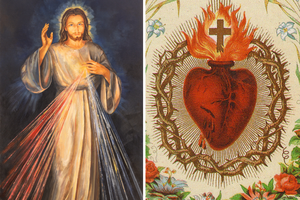Heeding the Mary and Divine Mercy Connection
St. Faustina's memorial being added to the Church calendar this May is a great reminder and signpost of the inseparable connection between Divine Mercy and Our Lady, Mother of Mercy

This May 18 Pope Francis decreed that St. Faustina Kowalska’s feast day be added to the Roman Calendar as an optional memorial to be celebrated by all on Oct. 5.
There’s a great lesson here — more than appears at first.
First, we know St. Faustina brought us the message of Divine Mercy through her Diary. Second, the date of the decree has great significance because it was the 100th anniversary of the birth of St. John Paul II — the pope of Divine Mercy and a great Marian pope. He canonized St. Faustina 20 years ago in April 2000. She became the first saint of the new millennium. He was closely connected with Our Lady of Fatima.
Third, this decree was given in May, the month of the Blessed Mother.
“I am not only Queen of Heaven, but also the Mother of Mercy and your Mother,” were the words Faustina heard Mary say during an apparition (Diary 330).
On another occasion Mary told St. Faustina the essential need to make God’s mercy known: “You have to speak to the world about his great mercy. … Speak to souls about this great mercy while it is still the time for (granting) mercy” (Diary 635).
Heaven wove together this beautiful connection with another revelation. On Sept. 4, 1993, John Paul II visited the Shrine of the Gate of the Dawn (Ostrabrama) in Vilnius, Lithuania, praying the Rosary with people before the miraculous icon of Our Lady of Mercy. There, in 1935, on the Sunday after Easter — now Divine Mercy Sunday — the image of Jesus, The Divine Mercy, that St. Faustina had had painted according to his direction, was shown and venerated publicly for the very first time.
Ah, the Rosary he was praying with the people. The Chaplet of Divine Mercy is prayed using the beads of the Rosary. There is that visual, tangible connection joining both the Divine Mercy devotion to Mary’s Rosary, and vice versa.
“Ultimately, Marian consecration leads to us to Divine Mercy,” says Marian Father Michael Gaitley in his book 33 Days to Morning Glory. Another time, he pointed out that the Fatima apparitions fittingly “begin and end with mercy” because our Blessed Mother’s “merciful purpose was to prevent her children from having to go through terrible suffering.”
Our Lady made the connection in the prayer she taught the children there to say after every decade of the Rosary: O my Jesus, forgive us our sins; save us from the fires of hell; lead all souls into heaven, especially those who are in most need of Thy mercy. As we pray it, this prayer is also a spiritual work of mercy that makes a direct connection to the message of Divine Mercy.
Twenty years after this prayer to add to the Rosary, St. Faustina had a vision on Sept. 1, 1937. She revealed in the Diary (1261),
“I saw the Lord Jesus, like a king in great majesty, looking down upon our earth with great severity; but because of his Mother’s intercession He prolonged the time of His mercy.” Our Mother of Mercy was interceding with her son, The Divine Mercy, for us.
Again, the connection. “If there is one thing Our Lady stressed at Fatima, it was the imperative repent,” wrote Servant of God, Jesuit Father John Hardon. It is one of the conditions of the Divine Mercy Sunday devotion, and receiving Divine Mercy.
Heaven gave us another confirmation of the indissoluble connection of Mary and Divine Mercy through St. John Paul II when he died on April 2, 2005. That day was both the First Saturday of the month, Mary’s day, and, at the hour at the end of the Vigil Mass of Divine Mercy Sunday. Heaven was going to welcome the pope who promoted the Rosary and Divine Mercy.
And don’t forget that “Mother of Mercy” and “Virgin most merciful” are two of the invocations in the Litany of Loreto, again connecting Mary with Mercy itself.
Marian Father Donald Calloway whose congregation promotes both Divine Mercy and the Rosary and Marian devotion, wrote Purest of All Lilies: The Virgin Mary in the Spirituality of St. Faustina. When asked about the Mary and Divine Mercy connection during an interview, he explained, “The Divine Mercy and Mary Immaculate go hand in hand. The Immaculate Conception is really the masterpiece of Divine Mercy. Mary is the perfect fruit of Christ's redemption and love. So when you bring Mary and Divine Mercy together, they really compliment each other and they point to each other. It's kind of like the sun and the moon. Jesus is the sun; Mary's the moon. She reflects the sun. John Paul II wrote in his encyclical, Dives Misericordia, that the one who had the greatest knowledge and understanding of Divine Mercy was Mary, because she received it, then she gives it — Divine Mercy, Jesus Incarnate — to the world. So she is Mother of Mercy, Mediatrix of Mercy. She's the one who gives us Jesus, and also the one who gives us the graces that Jesus won for us.”
Mary, Our Mother, Divine Mercy — could we want for anything more?
- Keywords:
- divine mercy
- st. faustina

















